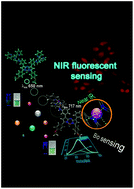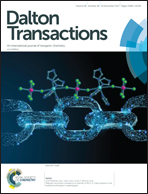Near-infrared aza-BODIPY fluorescent probe for selective Cu2+ detection and its potential in living cell imaging†
Abstract
A near-infrared (NIR) fluorescent sensor 1 composed of an aza-boron-dipyrromethene (aza-BODIPY) core covalently bound to two di-2-picolylamine moieties was conceived for Cu2+ detection in aqueous solutions. Spectroscopic properties and binding abilities with several metal ions were investigated in phosphate buffered saline (pH 7.4): acetonitrile (95 : 5 v/v) with Triton X-100 via fluorometric titrations. The fluorescence of sensor 1 was quenched selectively by cupric ions in the presence of alkali- and transition-metal-ions. A detection limit of 13 ppb was measured for this system, and this is significantly lower than permissible levels of Cu2+ in drinking water according to the guidelines described by the U.S. Environmental Protection Agency (EPA) and by the World Health Organization (WHO). Application of the sensor in detecting Cu2+ in HepG2 cells was demonstrated.



 Please wait while we load your content...
Please wait while we load your content...